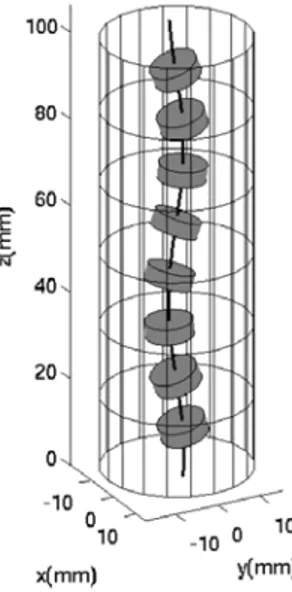Any correspondence concerning this service should be sent to the repository administrator:
staff-oatao@inp-toulouse.fr
Official URL:
http://www.euromech.org/conferences/EFMC/EFMC9
This is an author-deposited version published in:
http://oatao.univ-toulouse.fr/
Eprints ID: 10391
To cite this version:
Ern, Patricia and Brosse, Nicolas The periodic motion of a disk freely falling in a
tube. (2013) In: 9th Euromech Fluid Mechanics Conference (EFMC9), 09
September 2012 - 13 September 2012 (Rome, Italy).
Open Archive Toulouse Archive Ouverte (OATAO)
OATAO is an open access repository that collects the work of Toulouse researchers and
makes it freely available over the web where possible.
The periodic motion of a disk freely falling in a tube
P. Ern
∗, N. Brosse
∗This study is devoted to the rectilinear and periodic paths of an axisymmetric solid body (short-length cylinder and disk of diameter d, thickness h and aspect ratio 3 ≤ χ = d/h ≤ 10) falling in a vertical tube of diameter D. Three-dimensional trajectography was used to record the body motion (see figure 1). We investigated the influence of the confinement ratio (S = d/D) on the characteristics of the body motion, for different aspect ratios and Reynolds numbers (80 < Re < 320), and a density ratio between the fluid and the body close to unity. The critical Reynolds number for the onset of the periodic motion decreases with S in the case of thin bodies (χ = 10), whereas it appears unaffected by S for thicker bodies (χ = 3 and 6). For all aspect ratios, the mean fall velocity of the body decreases when S increases. The characteristics of the oscillatory motion are also strongly modified by the confinement ratio. A thick body (χ = 3) tends to stabilize and to go back to a rectilinear path when the confinement ratio increases, while a thin body (χ = 10) displays oscillations of growing amplitude with S until it touches the tube (at about S = 0.5). However, the amplitudes of the oscillatory motion of bodies with a given aspect ratio gather on a unique curve for all S (including the case with no confinement, S = 0), when plotted as a function of the relative distance of the Reynolds numbers of the bodies to the threshold of path instability for each confinement ratio S.
∗Institut de M´ecanique des Fluides de Toulouse, Universit´e de Toulouse and CNRS, All´ee du Prof.
C. Soula, 31400 Toulouse, France
Figure 1: Three-dimensional view of the path of a body of aspect ratio χ = 3 falling in a tube with S = 0.32 and Re = 245. The grid represents the wall of the tube.
